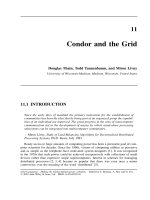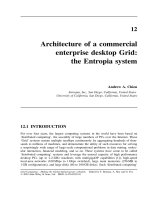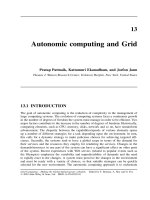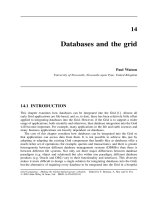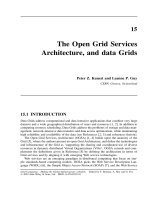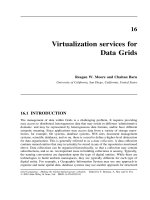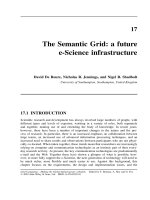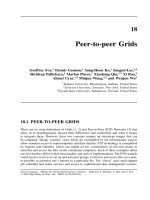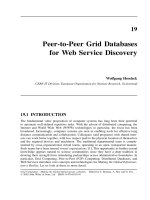Tài liệu Grid Computing P14 doc
Bạn đang xem bản rút gọn của tài liệu. Xem và tải ngay bản đầy đủ của tài liệu tại đây (148.57 KB, 22 trang )
14
Databases and the grid
Paul Watson
University of Newcastle, Newcastle upon Tyne, United Kingdom
14.1 INTRODUCTION
This chapter examines how databases can be integrated into the Grid [1]. Almost all
early Grid applications are file-based, and so, to date, there has been relatively little effort
applied to integrating databases into the Grid. However, if the Grid is to support a wider
range of applications, both scientific and otherwise, then database integration into the Grid
will become important. For example, many applications in the life and earth sciences and
many business applications are heavily dependent on databases.
The core of this chapter considers how databases can be integrated into the Grid so
that applications can access data from them. It is not possible to achieve this just by
adopting or adapting the existing Grid components that handle files as databases offer a
much richer set of operations (for example, queries and transactions), and there is greater
heterogeneity between different database management systems (DBMSs) than there is
between different file systems. Not only are there major differences between database
paradigms (e.g. object and relational) but also within one paradigm, different database
products (e.g. Oracle and DB2) vary in their functionality and interfaces. This diversity
makes it more difficult to design a single solution for integrating databases into the Grid,
but the alternative of requiring every database to be integrated into the Grid in a bespoke
Grid Computing – Making the Global Infrastructure a Reality. Edited by F. Berman, A. Hey and G. Fox
2003 John Wiley & Sons, Ltd ISBN: 0-470-85319-0
364
PAUL WATSON
fashion would result in a much-wasted effort. Managing the tension between the desire to
support the full functionality of different database paradigms, while also trying to produce
common solutions to reduce effort, is key to designing ways of integrating databases into
the Grid.
The diversity of DBMSs also has other important implications. One of the main hopes
for the Grid is that it will encourage the publication of scientific data in a more open
manner than is currently the case. If this occurs, then it is likely that some of the greatest
advances will be made by combining data from separate, distributed sources to produce
new results. The data that applications wish to combine would have been created by
a set of different researchers who would often have made local, independent decisions
about the best database paradigm and design for their data. This heterogeneity presents
problems when data is to be combined. If each application has to include its own, bespoke
solutions to federating information, then similar solutions will be reinvented in different
applications, and will be a waste of effort. Therefore, it is important to provide generic
middleware support for federating Grid-enabled databases.
Yet another level of heterogeneity needs to be considered. While this chapter focuses
on the integration of structured data into the Grid (e.g. data held in relational and object
databases), there will be the need to build applications that also access and federate other
forms of data. For example, semi-structured data (e.g. XML) and relatively unstructured
data (e.g. scientific papers) are valuable sources of information in many fields. Further,
this type of data will often be held in files rather than in a database. Therefore, in some
applications there will be a requirement to federate these types of data with structured
data from databases.
There are therefore two main dimensions of complexity to the problem of integrating
databases into the Grid: implementation differences between server products within a
database paradigm and the variety of database paradigms. The requirement for database
federation effectively creates a problem space whose complexity is abstractly the product
of these two dimensions. This chapter includes a proposal for a framework for reducing
the overall complexity.
Unsurprisingly, existing DBMSs do not currently support Grid integration. They are,
however, the result of many hundreds of person-years of effort that allows them to provide
a wide range of functionality, valuable programming interfaces and tools and important
properties such as security, performance and dependability. As these attributes will be
required by Grid applications, we strongly believe that building new Grid-enabled DBMSs
from scratch is both unrealistic and a waste of effort. Instead we must consider how to
integrate existing DBMSs into the Grid. As described later, this approach does have its
limitations, as there are some desirable attributes of Grid-enabled databases that cannot be
added in this way and need to be integrated in the underlying DBMS itself. However, these
are not so important as to invalidate the basic approach of building on existing technology.
The danger with this approach is when a purely short-term view is taken. If we restrict
ourselves to considering only how existing databases servers can be integrated with exist-
ing Grid middleware, then we may lose sight of long-term opportunities for more powerful
connectivity. Therefore, we have tried to identify both the limitations of what can be
achieved in the short term solely by integrating existing components and by identifying
cases in which developments to the Grid middleware and database server components
DATABASES AND THE GRID
365
themselves will produce long-term benefits. An important aspect of this will occur nat-
urally if the Grid becomes commercially important, as the database vendors will then
wish to provide ‘out-of-the-box’ support for Grid integration, by supporting the emerging
Grid standards. Similarly, it is vital that those designing standards for Grid middleware
take into account the requirements for database integration. Together, these converging
developments would reduce the amount of ‘glue’ code required to integrate databases into
the Grid.
This chapter addresses three main questions: what are the requirements of Grid-enabled
databases? How far do existing Grid middleware and database servers go towards meeting
these requirements? How might the requirements be more fully met? In order to answer
the second question, we surveyed current Grid middleware. The Grid is evolving rapidly,
and so the survey should be seen as a snapshot of the state of the Grid as it was at the
time of writing. In addressing the third question, we focus on describing a framework for
integrating databases into the Grid, identifying the key functionalities and referencing rel-
evant work. We do not make specific proposals at the interface level in this chapter – this
work is being done in other projects described later.
The structure of the rest of the chapter is as follows. Section 14.2 defines terminology
and then Section 14.3 briefly lists the possible range of uses of databases in the Grid.
Section 14.4 considers the requirements of Grid-connected databases and Section 14.5
gives an overview of the support for database integration into the Grid offered by current
Grid middleware. As this is very limited indeed, we go on to examine how the require-
ments of Section 14.4 might be met. This leads us to propose a framework for allowing
databases to be fully integrated into the Grid, both individually (Section 14.6) and in
federations (Section 14.7). We end by drawing conclusions in Section 14.8.
14.2 TERMINOLOGY
In this section, we briefly introduce the terminology that will be used through the chapter.
A database is a collection of related data. A database management system (DBMS)
is responsible for the storage and management of one or more databases. Examples of
DBMS are Oracle 9i, DB2, Objectivity and MySQL. A DBMS will support a particular
database paradigm, for example, relational, object-relational or object. A DBS is cre-
ated, using a DBMS, to manage a specific database. The DBS includes any associated
application software.
Many Grid applications will need to utilise more than one DBS. An application can
access a set of DBS individually, but the consequence is that any integration that is
required (e.g. of query results or transactions) must be implemented in the application. To
reduce the effort required to achieve this, federated databases use a layer of middleware
running on top of autonomous databases to present applications with some degree of
integration. This can include integration of schemas and query capability.
DBS and DBMS offer a set of services that are used to manage and to access the
data. These include query and transaction services. A service provides a set of related
operations.
366
PAUL WATSON
14.3 THE RANGE OF USES OF DATABASES
ON THE GRID
As well as the storage and retrieval of the data itself, databases are suited to a variety
of roles within the Grid and its applications. Examples of the potential range of uses of
databases in the Grid include the following:
Metadata: This is data about data, and is important as it adds context to the data, aid-
ing its identification, location and interpretation. Key metadata includes the name and
location of the data source, the structure of the data held within it, data item names and
descriptions. There is, however, no hard division between data and metadata – one appli-
cation’s metadata may be another’s data. For example, an application may combine data
from a set of databases with metadata about their locations in order to identify centres of
expertise in a particular category of data (e.g. a specific gene). Metadata will be of vital
importance if applications are to be able to discover and automatically interpret data from
large numbers of autonomously managed databases. When a database is ‘published’ on
the Grid, some of the metadata will be installed into a catalogue (or catalogues) that can
be searched by applications looking for relevant data. These searches will return a set
of links to databases whose additional metadata (not all the metadata may be stored in
catalogues) and data can then be accessed by the application. The adoption of standards
for metadata will be a key to allowing data on the Gird to be discovered successfully.
Standardisation efforts such as Dublin Core [2], along with more generic technologies
and techniques such as rdf [3] and ontologies, will be as important for the Grid as they
are expected to become to the Semantic Web [4]. Further information on the metadata
requirements of early Grid applications is given in Reference [5].
Provenance: This is a type of metadata that provides information on the history of data.
It includes information on the data’s creation, source, owner, what processing has taken
place (including software versions), what analyses it has been used in, what result sets
have been produced from it and the level of confidence in the quality of information.
An example would be a pharmaceutical company using provenance data to determine
what analyses have been run on some experimental data, or to determine how a piece of
derived data was generated.
Knowledge repositories: Information on all aspects of research can be maintained through
knowledge repositories. This could, for example, extend provenance by linking research
projects to data, research reports and publications.
Project repositories: Information about specific projects can be maintained through project
repositories. A subset of this information would be accessible to all researchers through
the knowledge repository. Ideally, knowledge and project repositories can be used to link
data, information and knowledge, for example, raw data
→
result sets
→
observations
→
models and simulations
→
observations
→
inferences
→
papers.
DATABASES AND THE GRID
367
In all these examples, some form of data is ‘published’ so that it can be accessed
by Grid applications. There will also be Grid components that use databases internally,
without directly exposing their contents to external Grid applications. An example would
be a performance-monitoring package that uses a database internally to store information.
In these cases, Grid integration of the database is not a requirement and so does not fall
within the scope of this chapter.
14.4 THE DATABASE REQUIREMENTS OF GRID
APPLICATIONS
A typical Grid application, of the sort with which this chapter is concerned, may consist
of a computation that queries one or more databases and carries out further analysis on
the retrieved data. Therefore, database access should be seen as being only one part of a
wider, distributed application. Consequently, if databases are to be successfully integrated
into Grid applications, there are two sets of requirements that must be met: firstly, those
that are generic across all components of Grid applications and allow databases to be
‘first-class components’ within these applications, and secondly, those that are specific to
databases and allow database functionality to be exploited by Grid applications. These
two categories of requirements are considered in turn in this section.
If computational and database components are to be seamlessly combined to create
distributed applications, then a set of agreed standards will have to be defined and will
have to be met by all components. While it is too early in the lifetime of the Grid
to state categorically what all the areas of standardisation will be, work on existing
middleware systems (e.g. CORBA) and emerging work within the Global Grid Forum,
suggest that security [6], accounting [7], performance monitoring [8] and scheduling [9]
will be important. It is not clear that database integration imposes any additional require-
ments in the areas of accounting, performance monitoring and scheduling, though it does
raise implementation issues that are discussed in Section 14.6. However, security is an
important issue and is now considered.
An investigation into the security requirements of early data-oriented Grid applica-
tions [5] shows the need for great flexibility in access control. A data owner must be
able to grant and revoke access permissions to other users, or delegate this authority to a
trusted third party. It must be possible to specify all combinations of access restrictions
(e.g. read, write, insert, delete) and to have fine-grained control over the granularity of the
data against which they can be specified (e.g. columns, sets of rows). Users with access
rights must themselves be able to delegate access rights to other users or to an application.
Further, they must be able to restrict the rights they wish to delegate to a subset of the
rights they themselves hold. For example, a user with read and write permission to a
dataset may wish to write and distribute an application that has only read access to the
data. Role-based access, in which access control is based on user role as well as on named
individuals, will be important for Grid applications that support collaborative working.
The user who performs a role may change over time, and a set of users may adopt the
same role concurrently. Therefore, when a user or an application accesses a database they
must be able to specify the role that they wish to adopt. All these requirements can be met
368
PAUL WATSON
‘internally’ by existing database server products. However, they must also be supported
by any Grid-wide security system if it is to be possible to write Grid applications all of
whose components exist within a single unified security framework.
Some Grid applications will have extreme performance requirements. In an application
that performs CPU-intensive analysis on a huge amount of data accessed by a complex
query from a DBS, achieving high performance may require utilising high-performance
servers to support the query execution (e.g. a parallel database server) and the computation
(e.g. a powerful compute server such as a parallel machine or cluster of workstations).
However, this may still not produce high performance, unless the communication between
the query and analysis components is optimised. Different communication strategies will
be appropriate in different circumstances. If all the query results are required before
analysis can begin, then it may be best to transfer all the results efficiently in a single block
from the database server to the compute server. Alternatively, if a significant computation
needs to be performed on each element of the result set, then it is likely to be more
efficient to stream the results from the DBS to the compute server as they are produced.
When streaming, it is important to optimise communication by sending data in blocks,
rather than as individual items, and to use flow control to ensure that the consumer is not
swamped with data. The designers of parallel database servers have built up considerable
experience in designing these communications mechanisms, and this knowledge can be
exploited for the Grid [10–12].
If the Grid can meet these requirements by offering communications mechanisms rang-
ing from fast large file transfer to streaming with flow control, then how should the most
efficient mechanism be selected for a given application run? Internally, DBMSs make
decisions on how best to execute a query through the use of cost models that are based
on estimates of the costs of the operations used within queries, data sizes and access
costs. If distributed applications that include database access are to be efficiently mapped
onto Grid resources, then this type of cost information needs to be made available by the
DBMS to application planning and scheduling tools, and not just used internally. Armed
with this information a planning tool can not only estimate the most efficient communi-
cation mechanism to be used for data flows between components but also decide what
network and computational resources should be acquired for the application. This will
be particularly important where a user is paying for the resources that the application
consumes: if high-performance platforms and networks are underutilised then money is
wasted, while a low-cost, low-performance component that is a bottleneck may result in
the user’s performance requirements not being met.
If cost information was made available by Grid-enabled databases, then this would
enable a potentially very powerful approach to writing and planning distributed Grid
applications that access databases. Some query languages allow user-defined operation
calls in queries, and this can allow many applications that combine database access and
computation to be written as a single query (or if not then at least parts of them may be
written in this way). The Object Database Management Group (ODMG) Object Query
Language (OQL) is an example of one such query language [13]. A compiler and opti-
miser could then take the query and estimate how best to execute it over the Grid, making
decisions about how to map and schedule the components of such queries onto the Grid,
and the best ways to communicate data between them. To plan such queries efficiently
DATABASES AND THE GRID
369
requires estimates of the cost of operation calls. Mechanisms are therefore required for
these to be provided by users, or for predictions to be based on measurements collected
at run time from previous calls (so reinforcing the importance of performance-monitoring
for Grid applications). The results of work on compiling and executing OQL queries on
parallel object database servers can fruitfully be applied to the Grid [12, 14].
We now move beyond considering the requirements that are placed on all Grid middle-
ware by the need to support databases, and consider the requirements that Grid applications
will place on the DBMSs themselves. Firstly, there appears to be no reason Grid appli-
cations will not require at least the same functionality, tools and properties as other
types of database applications. Consequently, the range of facilities already offered by
existing DBMSs will be required. These support both the management of data and the
management of the computational resources used to store and process that data. Specific
facilities include
•
query and update facilities
•
programming interface
•
indexing
•
high availability
•
recovery
•
replication
•
versioning
•
evolution
•
uniform access to data and schema
•
concurrency control
•
transactions
•
bulk loading
•
manageability
•
archiving
•
security
•
integrity constraints
•
change notification (e.g. triggers).
Many person-years of effort have been spent embedding this functionality into existing
DBMS, and so, realistically, integrating databases into the Grid must involve building on
existing DBMS, rather than on developing completely new, Grid-enabled DBMS from
scratch. In the short term, this may place limitations on the degree of integration that
is possible (an example is highlighted in Section 14.6), but in the longer term, there is
the possibility that the commercial success of the Grid will remove these limitations by
encouraging DBMS producers to provide built-in support for emerging Grid standards.
We now consider whether Grid-enabled databases will have requirements beyond those
typically found in existing systems. The Grid is intended to support the wide-scale sharing
of large quantities of information. The likely characteristics of such systems may be
expected to generate the following set of requirements that Grid-enabled databases will
have to meet:
370
PAUL WATSON
Scalability: Grid applications can have extremely demanding performance and capacity
requirements. There are already proposals to store petabytes of data, at rates of up to
1 terabyte per hour, in Grid-accessible databases [15]. Low response times for complex
queries will also be required by applications that wish to retrieve subsets of data for
further processing. Another strain on performance will be generated by databases that are
accessed by large numbers of clients, and so will need to support high access throughput.
Popular, Grid-enabled information repositories will fall into this category.
Handling unpredictable usage: The main aim of the Grid is to simplify and promote the
sharing of resources, including data. Some of the science that will utilise data on the
Grid will be explorative and curiosity-driven. Therefore, it will be difficult to predict in
advance the types of accesses that will be made to Grid-accessible databases. This differs
from most existing database applications in which types of access can be predicted. For
example, many current e-Commerce applications ‘hide’ a database behind a Web interface
that only supports limited types of access. Further, typical commercial ‘line-of-business’
applications generate a very large number of small queries from a large number of users,
whereas science applications may generate a relatively small number of large queries,
with much greater variation in time and resource usage. In the commercial world, data
warehouses may run unpredictable workloads, but the computing resources they use are
deliberately kept independent of the resources running the ‘line-of-business’ applications
from which the data is derived. Providing open, ad hoc access to scientific databases,
therefore, raises the additional problem of DBMS resource management. Current DBMSs
offer little support for controlling the sharing of their finite resources (CPU, disk IOs and
main memory cache usage). If they were exposed in an open Grid environment, little
could be done to prevent deliberate or accidental denial of service attacks. For example,
we want to be able to support a scientist who has an insight that running a particular
complex query on a remote, Grid-enabled database could generate exciting new results.
However, we do not want the execution of that query to prevent all other scientists from
accessing the database for several hours.
Metadata-driven access: It is already generally recognised that metadata will be very
important for Grid applications. Currently, the use of metadata in Grid applications tends
to be relatively simple – it is mainly for mapping the logical names for datasets into
the physical locations where they can be accessed. However, as the Grid expands into
new application areas such as the life sciences, more sophisticated metadata systems and
tools will be required. The result is likely to be a Semantic Grid [16] that is analogous
to the Semantic Web [4]. The use of metadata to locate data has important implications
for integrating databases into the Grid because it promotes a two-step access to data.
In step one, a search of Metadata catalogues is used to locate the databases containing
the data required by the application. That data is then accessed in the second step. A
consequence of two-step access is that the application writer does not know the specific
DBS that will be accessed in the second step. Therefore, the application must be general
enough to connect and interface to any of the possible DBSs returned in step one. This is
straightforward if all are built from the same DBMS, and so offer the same interfaces to

